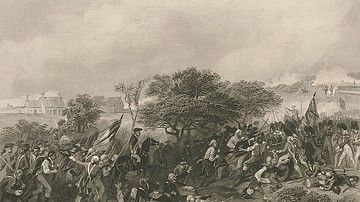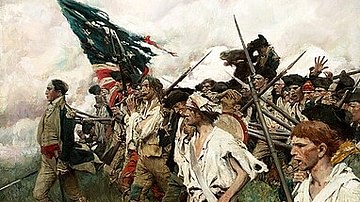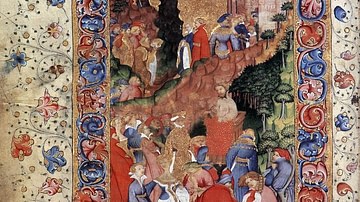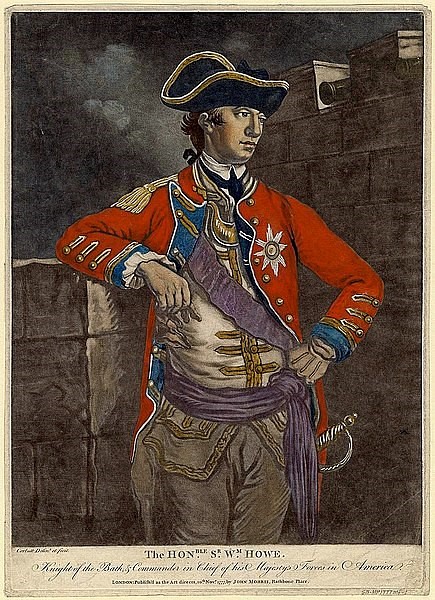
Sir William Howe (1729-1814) was a British military officer and politician, most notable for his role as commander-in-chief of the British army during the initial years of the American Revolutionary War (1775-1783). Despite several significant victories, including the captures of New York City and Philadelphia, he was unable to decisively defeat the Continental Army and resigned in April 1778.
Family & Early Career
William Howe was born on 10 August 1729 in Nottinghamshire, England, to an aristocratic family of high pedigree. For generations, the Howes had represented Nottinghamshire in the House of Commons, and in 1710, William Howe's grandfather had been granted the title of viscount in the Irish Peerage. William's father, Emanuel Scorpe Howe, was the 2nd Viscount Howe and served in various political offices including as the Governor of Barbados. The maternal side of his family was no less aristocratic; indeed, William's grandmother, Sophia von Kielmansegg, had been the illegitimate half-sister of King George I of Great Britain (r. 1714-1727), and his mother, Charlotte, was a constant and influential figure in the courts of both King George II (r. 1727-1760) and King George III (r. 1760-1820). It was through this courtly influence that Charlotte Howe helped procure important posts for her four sons.
William was the third of four sons born to Emanuel and Charlotte Howe, each of whom was destined for a distinguished military career. His eldest brother, George (1725-1758), became the 3rd Viscount Howe in 1735, the year that their father died. Ten years later, he enlisted in the British army, securing a position as an aide-de-camp to Prince William, Duke of Cumberland. William's second eldest brother, Richard (1726-1799), opted for a career in the navy, signing on with the fourth-rate ship HMS Pearl in 1739. By the time William finished his education at Eton, therefore, he was determined to follow his brothers into the military. On 18 September 1746, at age 17, he signed on as a cornet with the Duke of Cumberland's Light Dragoons. All three of the eldest Howe brothers served in the War of the Austrian Succession (1740-1748), with George and William serving together under the Duke of Cumberland in Flanders. The fourth brother, Thomas Howe, joined the East India Company and became a renowned explorer.
Service in the French and Indian War
After the war, William Howe was promoted to lieutenant and transferred to the 20th Regiment of Foot, where he met and befriended a thin, energetic young major named James Wolfe. Howe spent the first part of the 1750s garrisoned in Scotland with this regiment; but when tensions between the British and French colonial empires blossomed into the Seven Years' War (1756-1763), he was sent to fight in North America. In December 1757, he was promoted to lieutenant colonel and was put in charge of a light infantry battalion in a division commanded by Wolfe, who himself had just been promoted to brigadier general. The following year, Wolfe's division participated in the Siege of Louisbourg, a French fortress at the mouth of the St. Lawrence River, the capture of which was a prerequisite for Britain's invasion of Canada.

On 8 June 1758, the British attempted an amphibious landing but came under heavy French fire. After sustaining heavy losses, Wolfe ordered a retreat, but Howe continued onward, eventually managing to land his battalion in a rocky inlet. Once Howe had established a beachhead, the rest of Wolfe's division turned around and landed, ready to begin the siege. The fortress fell on 26 July, and Howe was praised by General Wolfe, who referred to his unit as "the best trained battalion in all America" (Boatner, 523). This success was soon overshadowed by tragedy when Howe learned that his older brother, General George Howe, had been killed at the Battle of Fort Carillon (6-8 July 1758). George's death was widely mourned, both in Britain and in the colonies; indeed, the Massachusetts Assembly raised £250 to place a monument in Westminster Abbey in George Howe's honor. This display of respect for his brother greatly moved William Howe, who thereafter was sympathetic toward the Americans.
In 1759, Howe joined General Wolfe's expedition to Canada, leading the advance elements of the army up the St. Lawrence River to the Plains of Abraham, just outside the city of Quebec. In the subsequent Battle of the Plains of Abraham (13 September), General Wolfe was mortally wounded, but the British succeeded in capturing Quebec. The following year, Howe participated in the capture of Montreal, which consolidated British control of Canada and, in 1762, he served as adjutant general of the expedition that captured Havana from the Spanish. The Treaty of Paris of 1763 ended the war, with France ceding control of Canada to Britain.
Interwar Period
Howe returned to London in 1763 to take his place in the House of Commons; he had been elected to represent Nottinghamshire in the British Parliament in 1758, after the previous officeholder, his brother George, was killed. In Parliament, Howe's politics aligned with the Whigs, and he often spoke out in favor of the Thirteen Colonies during the debates over taxation; he opposed the passage of the Stamp Act (1765) and the Townshend Acts (1767-68), agreeing with the colonists that such measures were an overreach of Parliamentary authority. This disagreement between Parliament and the Thirteen Colonies continued to escalate, leading to outbursts of violence, such as the Boston Massacre (1770) and the Boston Tea Party (1773). By late 1774, war between the colonies and Great Britain appeared almost certain, but even at this late stage, Howe remained outwardly sympathetic to the colonies. He condemned the Intolerable Acts and promised his constituents that he would never accept any command that would require him to fight against the Americans.
In the meantime, his military service continued. In 1768, he was appointed lieutenant governor of the Isle of Wight, and in 1772, he achieved the rank of major general. By 1774, he was overseeing the training of infantrymen and was considered one of the top officers in the British army. It came as no surprise, then, that once the first shots of the American Revolution were fired at the Battles of Lexington and Concord (19 April 1775), Howe was offered the position of second-in-command to General Thomas Gage, commander of all British forces in North America. Despite his earlier promises, Howe accepted this command. He penned a letter to his constituents explaining his decision to go to America to fight the colonists: "my going thither was not of my seeking. I was ordered, and could not refuse, without incurring the odious name of backwardness to serve my country in distress" (Boatner, 523-24).
Bunker Hill & Capture of New York
On 25 May 1775, Howe arrived in Boston Harbor aboard the HMS Cerberus alongside two other British generals, Henry Clinton and John Burgoyne. Their job was to advise General Gage, who had found himself trapped in Boston with just 6,000 British regulars, surrounded by over 15,000 American militiamen. Howe, Clinton, and Burgoyne devised a plan in which the British would seize the heights outside Boston, a position from which they could sweep away the besieging American army. The Patriots, however, found out about the plan and preemptively seized the high ground on Breed's Hill before it could go into effect. This forced the British to act; on 17 June 1775, General Howe personally led 2,400 British soldiers in an assault on the American redoubt on Breed's Hill. The Americans were well-entrenched, and two British charges were repulsed before the redcoats finally managed to storm the redoubt. The engagement, known as the Battle of Bunker Hill, was a British victory, albeit a costly one; 1,056 British soldiers had been killed or wounded, including Howe's aide-de-camp, who had been shot dead at his side. Howe himself had miraculously gone uninjured, even though he had been leading his men from the front, but he never forgot the bloodshed on Breed's Hill.

Shortly after Bunker Hill, Gage was relieved of command. He was replaced by Howe, who was soon confirmed as commander-in-chief of all British forces in North America. Howe was immediately faced with the unpleasant chore of cleaning up Gage's mess; he was still trapped in Boston with thousands of Americans outside his door. By July 1775, this ragtag colonial force had been reorganized into the Continental Army, led by General George Washington, who was determined to secure a victory. During the winter of 1775-76, Washington had artillery brought down from Fort Ticonderoga, positioning these guns atop Dorchester Heights, which overlooked Boston. Now exposed to enemy artillery, Howe evacuated the city, sailing out of Boston Harbor on 17 March 1776, ending the Siege of Boston in an American victory.
Howe did not give up. He sailed to Halifax, Nova Scotia, to link up with a fleet commanded by his brother, Admiral Lord Richard Howe. The Howe brothers then sailed to New York Harbor, landing on Staten Island with 32,000 men, the largest expeditionary force Britain had yet sent out in any part of the world. Washington and the Continental Army had rushed to defend New York City from Howe and had built a series of fortifications atop Brooklyn Heights on Long Island. On 22 August, the British landed on Long Island and attacked the forward American positions five days later. During the Battle of Long Island, Howe was able to outflank the American position with the help of Loyalist guides, who showed him a path behind the Continental Army. The Americans suffered over 2,000 casualties and were forced to withdraw to New York City.
The Howes then reached out to the Second Continental Congress with an offer of peace; the brothers had been imbued with limited negotiating powers by the king's ministry. On 11 September, the Howes met with a congressional delegation on Staten Island but talks quickly broke down once the delegates refused to renounce American independence. On 15 September, Howe landed on Manhattan Island and entered New York City the same day, as Washington was forced to retreat further up Manhattan. Although Howe's offensive was initially checked at the Battle of Harlem Heights (16 September), he managed to deal the Americans two defeats at the Battle of White Plains (28 October) and the Battle of Fort Washington (16 November). For his string of victories, Howe was celebrated in London and was awarded a knighthood by King George III of Great Britain.
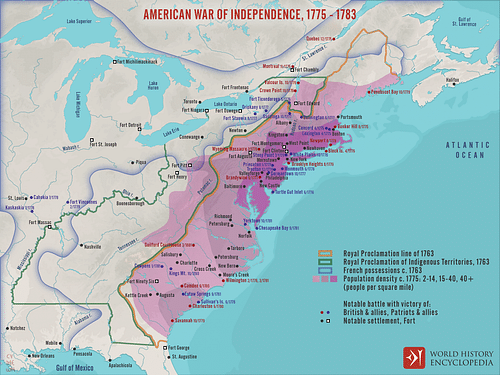
The fall of Fort Washington resulted in 2,800 American prisoners taken by the British, most of whom were interred in the British prison ships anchored off Brooklyn. Conditions aboard these ships were miserable; the men were often mistreated by their captors and deprived of food and clothing. Thousands of American prisoners died of malnutrition, disease, or neglect under British watch; although Howe was not personally involved in the cruelties inflicted by his prison officers, he certainly knew it was happening and turned a blind eye. This, perhaps, was the largest stain on his legacy.
Philadelphia Campaign
By the end of 1776, the Continental Army was on the run, having been chased through New Jersey and into Pennsylvania. By early December, disease and desertion had reduced the number of Continental soldiers to less than 3,000 effectives. If Howe had wanted, he could have continued to pursue the sick, hungry, and miserable Continental Army into Pennsylvania and destroyed it in one final battle; this certainly would have brought about the end of the rebellion. Instead, Howe moved his army into winter quarters. This was customary for European armies at the time, which typically did not fight in the winter unless absolutely necessary. Washington, however, was quick to take advantage of the delay, striking the Hessian and British troops at the Battle of Trenton (26 December 1776) and the Battle of Princeton (3 January 1777). These two victories revitalized the American war effort and likely saved Washington's army from destruction.
Howe, although frustrated by the losses, was not quick to act. He spent the remainder of the winter in his headquarters in New York City, attending fashionable balls and dinners, always in the company of his beautiful, young mistress Mrs. Elizabeth Loring. Much has been made of Howe's affair with the 24-year-old Mrs. Loring, the American wife of one of Howe's Loyalist officers. Some scornful contemporaries considered her to be the Cleopatra to his Mark Antony, the true reason why he was so sluggish in pursuing Washington. Their relationship became the subject of jokes in America, such as a well-known poem that went:
Sir William he,
smug as a flea,
lay all this time a-snoring,
nor dreamed of harm
as he lay warm,
in bed with Mrs. Loring. (Watson, 35).
Whatever the true reason for his delays, Howe was not neglectful of his military duties, as he spent the early months of 1777 planning a campaign to capture Philadelphia, the United States capital. If he succeeded, he would control the two most important cities in the United States (the other being New York) and could probably force Washington to fight a decisive battle that he would likely lose; in other words, it was a campaign that would win him the war. On 24 July 1777, he embarked 18,000 men on ships and set sail for Chesapeake Bay, landing in Maryland in late August. After marching into Pennsylvania, Howe defeated Washington's army at the Battle of Brandywine (11 September). The Continental Army, however, was able to retreat intact, depriving Howe of the decisive victory he needed.
On 24 September, Howe entered Philadelphia uncontested, though he failed to capture the Continental Congress, which had escaped to York, Pennsylvania. He defeated Washington once more at the Battle of Germantown (4 October) and, in mid-November, captured forts Mercer and Mifflin on the Delaware River, opening that vital waterway to the British. Despite these successes, Howe had failed to end the war; Washington's army rested at Valley Forge, resupplying and retraining, and although the British controlled Philadelphia, the United States showed no sign of crumbling. Howe blamed the British government for this failure, arguing that he would have achieved his goals if they had sent him the reinforcements and supplies he had requested.
In October 1777, a frustrated Howe wrote to London offering his resignation, citing his lack of governmental support as the reason. He spent the rest of the winter in Philadelphia, attending high-end dinners and carousing with Mrs. Loring until April 1778, when he received word that his resignation had been accepted. This was terrible news to Howe's British officers, who had come to love and respect their commander. On 18 May 1778, Captain John André and Captain Oliver De Lancey organized an extravaganza to mark Howe's departure from the army. Known as the Mischianza, it lasted from 4 p.m. to 4 a.m. and featured decorated barges, banquets, fireworks, and even a mock tournament between knights. It ended with an actress dressed as an allegory of Fame honoring Howe with the words, "Thy laurels shall never fade" (Boatner, 710). The next day, Sir William boarded a ship and returned to England.
Later Life & Death
Upon his return to London, Howe's reception was much cooler than it had been during the Mischianza. He was accused by his critics, including his former second-in-command Sir Henry Clinton, of passing up multiple golden opportunities to destroy Washington and win the war; Clinton, quite vitriolically, wrote "had [Howe] gone to the Devil before he was sent to America, it had been a saving of infamy to himself and indelible dishonor to his country" (Boatner, 526). In May 1779, Parliament opened an inquiry into Howe's conduct but was unable to find any evidence of incompetence or mismanagement. In 1780, Howe published a response to accusations made by Loyalist Joseph Galloway, who claimed that Howe's sympathies for the colonists had led him to deliberately sabotage the British war effort. That same year, he lost his re-election to the House of Commons.
Howe never again reached the same level of popularity that he had enjoyed in 1776, after having taken New York City. Despite his fall from grace, he soon returned to public life; in 1782, he was appointed lieutenant general of the ordinance and was appointed to the king's Privy Council. In 1793, when Britain entered the French Revolutionary Wars (1792-1802), he was promoted to full general and oversaw the defense of the home island but did not see any action during that conflict. His brother Richard, on the other hand, won renown for the Howe family when he beat a French fleet in a 1794 naval action known as the Glorious First of June. When Richard died in August 1799, the title of Viscount passed to Sir William, who became the 5th Viscount Howe.
In 1803, Sir William Howe resigned from his public positions, citing ill health. His health continued to decline over the course of the next decade until he died at Twickenham on 12 July 1814, at the age of 84. He was survived by his wife Frances Connolly (they had married in 1765), who lived for three more years. Since Howe had no children, his titles died with him.





